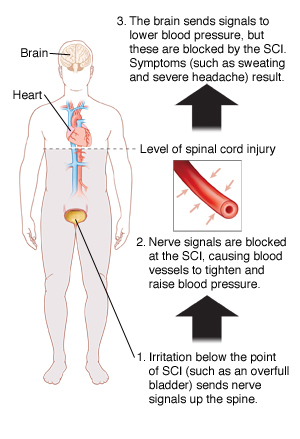Autonomic Dysreflexia
People with spinal cord injury (SCI) may be at risk for a serious problem called autonomic dysreflexia (AD). If you have an SCI in your upper back (at level T6 or higher), it can cause dangerously high blood pressure and a slowed heart rate. You should be aware of this problem and how it could affect you.
 |
| During an AD episode, blood pressure stays high until the irritation is relieved. An AD episode that is not treated can lead to serious complications. |
Understanding AD
AD is unusual within the first month of SCI. But it often appears within the first year. AD occurs in episodes. Episodes are usually triggered by irritation to the body below the point of the SCI. This is often as minor as a full bladder. But it causes an abnormal response in the nervous system. This makes the blood vessels tighten. As a result, the blood pressure rises quickly. This can lead to stroke and even death. So steps must be taken right away to find and ease the irritation. You may need emergency treatment.
Symptoms of an AD episode
An AD episode can occur at any time. It can have several symptoms. Along with high blood pressure, these include:
-
Severe, pounding headache
-
Changes in heart rate (slow pulse)
-
Sweating and blotchiness of the skin above the SCI, and pale, cold skin below it
-
Blurred vision
-
Stuffy nose
-
Anxiety
-
Upset stomach (nausea)
-
Goose bumps
Triggers of AD episodes
The most common triggers of AD episodes are:
-
A bladder problem. This is most often an overfull bladder. This can happen if you don't use a catheter. Or it can happen because of a clogged or kinked indwelling catheter. A urinary tract infection (UTI) can also be a trigger.
-
A bowel problem. This is often a bowel filled with stool or gas. Or it could be an infection or hemorrhoids. Stimulating your bowel with your finger (digital stimulation) as part of a bowel program is another possible trigger.
-
Other sources of discomfort. These include any other type of irritation. They could be wounds, pressure injuries, broken bones, and even ingrown nails or sunburn. Sexual arousal, menstruation, and pregnancy and labor can also trigger an AD episode.
What to do during an AD episode
It's critical to get treatment of an AD episode right away. You or your caregiver should take the following steps if you have symptoms of an episode:
-
Sit up. This can help lower blood pressure. Keep your head raised. Your legs should be lowered if possible. Also loosen any tight clothing, such as a belt or bra.
-
Monitor the blood pressure. It should be checked every 2 to 5 minutes.
-
Find and relieve the cause of the problem. Check your bladder and bowel first. Check the catheter (if used) and empty your bladder. If your bowel is full, empty it right away. Next, check for skin problems. These could be cuts or any kind of pressure on your skin. Also look for ingrown toenails. And check for any of the other possible triggers listed above.
-
If the problem can't be found or relieved, call 911 or emergency services right away. In the meantime, take blood pressure medicines if they have been prescribed for this purpose. These can help keep the blood pressure under control until the irritation is relieved.
Preventing AD episodes
AD episodes can’t always be prevented. But good self-care is key to reducing the number of episodes you have. These steps can help:
-
Prevent your bladder from getting too full or infected such as by urinary tract infection (UTI). If you use a catheter, check it often for blockages.
-
Follow a regular bowel program as instructed by your healthcare provider.
-
Change positions often to ease pressure on the skin from sitting or lying down.
-
Watch for sores or pressure spots on the skin.
-
Take all medicines as prescribed.
-
Choose shoes carefully. Check that they fit well and aren’t too tight. Your healthcare provider may help with this.
-
Check that there are no pebbles or other objects in your shoes. Also check that there are no wrinkles in your socks. And always wear socks with your shoes.
-
Don't get too much sun. Wear sunscreen and protective clothing.
-
Check water temperatures to prevent scalding.
-
Be extra careful to prevent falls, especially during transfers.
-
Keep a card in your wallet that describes AD, its triggers, and correct treatment. This can help healthcare providers who may not be familiar with the condition.
-
Form a good relationship with a healthcare provider who is familiar with AD and spinal cord injuries.
For the caregiver
You can help your loved one prevent AD episodes. Learn AD triggers and symptoms. Help manage your loved one’s catheter and bowel program. Watch for any skin problems or other injuries on the body below the point of the SCI. And know how to treat an AD episode. You can also help your loved one cope with AD. Living with the threat of an AD episode can be hard. Fear and depression are not uncommon in people who have frequent episodes of AD. Talk with your loved one about their feelings. Encourage your loved one to join a support group.